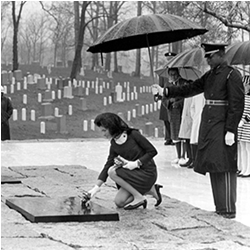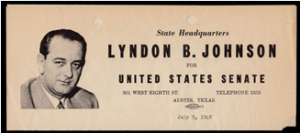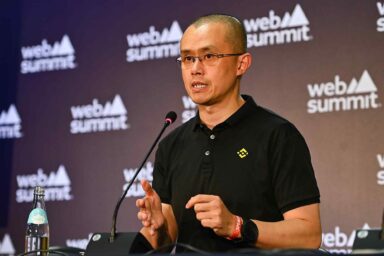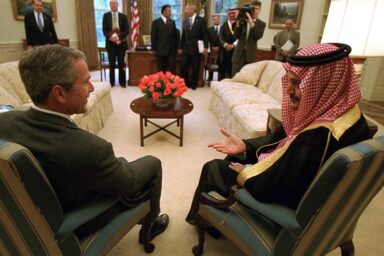What possible connection could there have been between George H.W. Bush and the assassination of John F. Kennedy? Or between the C.I.A. and the assassination? Or between Bush and the C.I.A.? For some people, apparently, making such connections was as dangerous as letting one live wire touch another. Here, in anticipation of the 50th anniversary of the JFK assassination in November, is the tenth and final part of a series of excerpts from WhoWhatWhy editor Russ Baker’s bestseller, Family of Secrets: The Bush Dynasty, America’s Invisible Government and the Hidden History of the Last Fifty Years. The story is a real-life thriller.
What possible connection could there have been between George H.W. Bush and the assassination of John F. Kennedy? Or between the C.I.A. and the assassination? Or between Bush and the C.I.A.? For some people, apparently, making such connections was as dangerous as letting one live wire touch another. Here, in anticipation of the 50th anniversary of the JFK assassination in November, is the tenth and final part of a series of excerpts from WhoWhatWhy editor Russ Baker’s bestseller, Family of Secrets: The Bush Dynasty, America’s Invisible Government and the Hidden History of the Last Fifty Years. The story is a real-life thriller.
Note: Although these excerpts do not contain footnotes, the book itself is heavily footnoted and exhaustively sourced. (The excerpts in Part 10 come from Chapter 7 of the book, and the titles and subtitles have been changed for this publication.)
For Part 1, please go here; Part 2, here; Part 3, here; Part 4, here; Part 5, here; Part 6, here; Part 7, here; Part 8, here; Part 9, here.
Jack Crichton, Stage Manager
If Poppy Bush was busy on November 22, 1963, so was his friend Jack Crichton. Bush’s fellow GOP candidate was a key figure in a web of military intelligence figures with deep connections to the Dallas Police Department – and as previously noted, to the pilot car of JFK’s motorcade.
Crichton came back into the picture within hours of Kennedy’s death and the subsequent arrest of Lee Harvey Oswald, when a peculiar cordon sanitaire went up around Marina Oswald. The first to her side was Republican activist and precinct chairman Ilya Mamantov, a vociferous anti-Communist who frequently lectured in Dallas on the dangers of the Red menace.
When investigators arrived, Mamantov stepped up as interpreter and embellished Marina’s comments to establish in no uncertain terms that the “leftist” Lee Harvey Oswald had been the gunman – the lone gunman – who killed the president.
It is interesting of course that the Dallas police would let an outsider – in particular, a right-wing Russian émigré – handle the delicate interpreting task. Asked by the Warren Commission how this happened, Mamantov said that he had received a phone call from Deputy Police Chief George Lumpkin. After a moment’s thought, Mamantov then remembered that just preceding Lumpkin’s call he had heard from Jack Crichton.
It was Crichton who had put the Dallas Police Department together with Mamantov and ensured his place at Marina Oswald’s side at this crucial moment.
Despite this revelation, Crichton almost completely escaped scrutiny. The Warren Commission never interviewed him. Yet, as much as anyone, Crichton embodied a confluence of interests within the oil-intelligence-military nexus. And he was closely connected to Poppy in their mutual efforts to advance the then-small Texas Republican Party, culminating in their acceptance of the two top positions on the state’s Republican ticket in 1964.

During World War II, Crichton had served in the Office of Strategic Services, the predecessor of the CIA. Postwar, he began working for the company of petroleum czar Everette DeGolyer and was soon connected in petromilitary circles at the highest levels. A review of hundreds of corporate documents and newspaper articles shows that when Crichton left DeGolyer’s firm in the early fifties he became involved in an almost incomprehensible web of companies with overlapping boards and ties to DeGolyer. Many of them were backed by some of North America’s most powerful families, including the Du Ponts of Delaware and the Bronfmans, owners of the liquor giant Seagram.
Crichton was so plugged into the Dallas power structure that one of his company directors was Clint Murchison Sr., king of the oil depletion allowance, and another was D. Harold Byrd, owner of the Texas School Book Depository building.
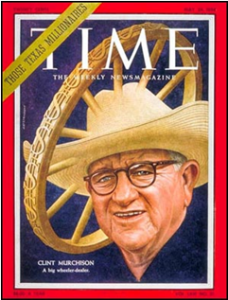
A typical example of this corporate cronyism came in 1952, when Crichton was part of a syndicate – including Murchison, DeGolyer, and the Du Ponts – that used connections in the fascist Franco regime to acquire rare drilling rights in Spain. The operation was handled by Delta Drilling, which was owned by Joe Zeppa of Tyler, Texas – the man who transported Poppy Bush from Tyler to Dallas on November 22, 1963.
It was in 1956 that the bayou-bred Crichton started up his own spy unit, the 488th Military Intelligence Detachment. He would serve as the intelligence unit’s only commander through November 22, 1963, continuing until he retired from the 488th in 1967, at which time he was awarded the Legion of Merit and cited for “exceptionally outstanding service.”
Gimme Shelter
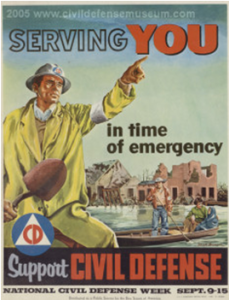 Besides his oil work and his spy work, the disarmingly folksy Crichton wore a third hat. He was an early and central figure in an important Dallas institution that is virtually forgotten today: the city’s Civil Defense organization. Launched in the early 1950s as cold war hysteria grew, it was a centerpiece of a kind of officially sanctioned panic response that, like the response to September 11, 2001, had a potential to serve other agendas.
Besides his oil work and his spy work, the disarmingly folksy Crichton wore a third hat. He was an early and central figure in an important Dallas institution that is virtually forgotten today: the city’s Civil Defense organization. Launched in the early 1950s as cold war hysteria grew, it was a centerpiece of a kind of officially sanctioned panic response that, like the response to September 11, 2001, had a potential to serve other agendas.
So avid and extensive was the Dallas civil defense effort that the conservative radio commentator Paul Harvey singled it out for special praise in his syndicated column in September 1960: “The Communists, since 1917, have sold Communism to more people than have been told about Christ after 2,000 years,” Harvey wrote, a sentiment common in rightist circles of the era.
But they got their converts one at a time. You and I can ‘convert’ two others to become militant Americans this week . . . That’s precisely the nature of the counterattack that has been mounted in Dallas.
Early in 1961, Crichton was the moving force behind a cold war readiness program called “Know Your Enemy,” which focused on the Communist intention to destroy the American way of life. In October 1961, Dallas mayor Earle Cabell introduced a short documentary Communist Encirclement – 1961. Afterward, the Dallas Morning News wrote that the Channel 8 switchboard was “flooded . . . with calls from viewers lauding the program, which deals frankly with Communist infiltration.”
So great was the sense of alarm that at the 1961 Texas State Fair in Dallas, 350 people per hour made their way through an exhibitor’s bomb shelter.
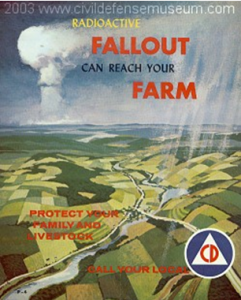 In April 1, 1962, Dallas Civil Defense, with Crichton heading its intelligence component, opened an elaborate underground command post under the patio of the Dallas Health and Science Museum. Because it was intended for “continuity-of-government” operations during an attack, it was fully equipped with communications equipment.
In April 1, 1962, Dallas Civil Defense, with Crichton heading its intelligence component, opened an elaborate underground command post under the patio of the Dallas Health and Science Museum. Because it was intended for “continuity-of-government” operations during an attack, it was fully equipped with communications equipment.
With this shelter in operation on November 22, 1963, it was possible for someone based there to communicate with police and other emergency services. There is no indication that the Warren Commission or any other investigative body or even JFK assassination researchers looked into this facility or the police and Army Intelligence figures associated with it.
On November 22, Crichton suggested Mamantov to the police department as the ideal person to interpret for Marina. His basis for knowing this was that in his role in military intelligence he maintained surveillance of Russians in Dallas, working closely in this regard with the police department.
Marina’s statements through Mamantov would play a crucial role in starting a chain of events that could have led to a U.S. missile strike on Cuba. In the hours following Kennedy’s assassination, the Dallas Police Department passed along information purportedly gleaned from Marina Oswald that suggested possible ties between her husband and the government of Cuba.
Though the information would turn out to be wrong, it was quickly passed to Army Intelligence, which then passed it along to the U.S. Strike Command at MacDill Air Force Base in Florida, the unit that would have directed an attack on the island had someone ordered it in those chaotic first hours after Kennedy’s death. That this sequence of events took place is confirmed by the original Army cable from military intelligence in Texas, declassified a decade later. What is not clear is how close matters ever got to zero hour.
A key element in this tangled tale is the little-appreciated overlap between the Dallas Police Department and Army Intelligence. As Crichton, who has since died, would reveal in a little-noted oral history in 2001, there were “about a hundred men in that unit and about forty or fifty of them were from the Dallas Police Department.”
Thus Crichton was a crucial figure linking many seemingly disparate elements: military intelligence, local police, the GOP, the White Russians, the oil community, George de Mohrenschildt, and Poppy Bush.
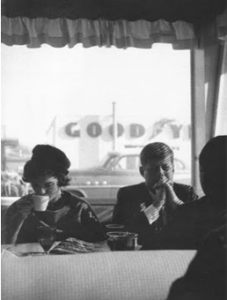
The Poppy and Jack Show
In the fall of 1963, about two months before JFK’s assassination, the two political neophytes Jack Crichton and George H.W. Bush both decided to mount GOP races for statewide office. The following year, they would head the Texas GOP’s ticket, with Crichton the nominee for governor and Bush for U.S. Senate. Both used the same lawyer, Pat Holloway, who worked out of the Republic National Bank Building.
The man who recruited them as candidates, state GOP chairman Peter O’Donnell, would several years later be forced by newspaper revelations to admit that his family foundation was a conduit for CIA funds.
Thus in November 1963, Bush and Crichton were essentially working in tandem. Given that alliance, Poppy would need to explain not only where he was on November 22 and why he tried so hard to hide that, but also what he knew about Crichton’s activities that day and about Crichton’s Army Intelligence colleagues in the pilot car of the motorcade.
In his oral history, Crichton couches his relationship with Bush in benign and casual terms. He says that he and Poppy “spoke from the same podiums and got to be fairly good acquaintances.” Their appearances on behalf of the Texas Republican Party evolved into a private friendship that continued over the years. “When he was head of the CIA, I called him one day and I said, ‘George, I’m coming to Washington, would you have time to play tennis?’ And he said ‘Yeah.’ He said, ’How would you like to play at The White House?’ And I said ‘Man, that’d be a real deal.’ So he said, ‘Well, I’ll have you a partner.’
A Crime of Commission
The Warren Commission’s official mandate had been to conduct “a thorough and independent investigation” of the assassination. However, along with subsequent investigative bodies, it failed to assemble, much less connect, even the most obvious of dots. Virtually everybody on the commission was a friend of Nixon’s or LBJ’s – or both.
The members shared another characteristic: they were, almost without exception, from the conservative establishment and definitely not Kennedy admirers who would have gone to any length to find the truth about JFK’s death. Along with Allen Dulles, members included Republican congressman Gerald Ford and John J. McCloy, a top operative for the Rockefeller family.
No doubt coincidentally, McCloy had been best man at the wedding of Henry Brunie, head of Empire Trust, which employed Jack Crichton and invested in de Mohrenschildt’s Cuban oil project.
Transcripts of the panel discussions produce a sense that the commission members and investigators were either incredibly naïve or else walking on eggshells. At an early executive session, Earl Warren told his colleagues, “We can rely upon the reports of the various agencies . . . the FBI, the Secret Service, and others.”
But commission member Senator Richard Russell, a conservative Georgia Democrat who headed the Armed Services Committee on which his friend Prescott Bush had served, made at least a brief stand.
“I hope,” he said, “that you’ll get someone with a most skeptical nature, sort of a devil’s advocate, who would take this FBI report and this CIA report and go through it and analyze every soft spot and contradiction in it, just as if he were prosecuting them.”
Many were already wondering whether CIA personnel might themselves know something about the assassination and how helpful they would be to the investigation. In one executive session, Russell turned to Dulles and expressed his doubts about Dulles’s compatriots:
I think you’ve got more faith in them [the CIA] than I have. I think they’ll doctor anything they hand to us.
During the commission’s investigation, Dulles and his colleagues sometimes traveled to Dallas, especially to hear witnesses who could not come to Washington. When they did, they set up their temporary conference room in the boardroom of the Republic National Bank. The decision to do so is revealing, if nothing else than of a striking lack of concern for appearances.
The Republic National Bank board was wired into the heart of the anti-Kennedy elite. The bank building itself stood out from other Dallas towers as an important symbol: the headquarters of Dresser Industries and of a number of corporations, law firms, and trusts connected with the Central Intelligence Agency, as well as being the building in which de Mohrenschildt himself had had offices.
A Fascinating Tan
Members of the commission were often absent during testimony. But George de Mohrenschildt’s appearance caused a stir. Among those present were Dulles, Ford, McCloy, and two commission attorneys. As de Mohrenschildt would recall in an early draft of his un-published memoirs:
The late Allen W. Dulles, former head of CIA, and a scholarly looking man, was there. He was, by the way, a friend of Mrs. Hugh Auchincloss [Jackie Kennedy’s mother] and he came over to talk to us amicably . . . What amazed me, looking backward at my testimony, was that whatever good I said about Lee Harvey Oswald seemed to be taken with a grain of salt as if the decision regarding hisguilt had already been formed.
Commission assistant counsel Albert E. Jenner Jr. was the staffer who conducted the interrogations of George and Jeanne de Mohrenschildt, which lasted two and a half days.
As he did with several other key witnesses, Jenner had private conversations with George de Mohrenschildt both inside and outside the hearing room. Perhaps to ensure that he would not be accused of something underhanded, he went out of his way to state the fact of those outside consultations for the record. Aside from asking de Mohrenschildt, on the record, to verify that everything they had discussed privately was reiterated in the public session, Jenner never made clear what the subject matter of those private conversations was.
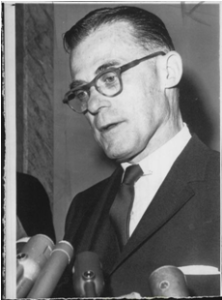
The transcript of the de Mohrenschildts’ testimony runs 165 pages. It reveals George to be a remarkably interesting, dynamic character, whose life resembled that of a fictional adventurer. But numerous points of his testimony, especially relating to his background and connections, cried out for further scrutiny. Instead, Jenner consistently demonstrated that he was either incompetent or deliberately incurious when it came to learning anything useful about de Mohrenschildt.
To wit, here is an exchange between Jenner and de Mohrenschildt, in Washington, on April 22, 1964, with a historian, Dr. Alfred Goldberg, present. Jenner, who had already read extensive FBI reports on de Mohrenschildt, could be forceful when he wanted answers. But most of his moves were away from substance. He seemed determined to reach the commission’s conclusion that de Mohrenschildt was a “highly individualistic person of varied interests,” and nothing more. In fact, Jenner stonewalled so assiduously that even de Mohrenschildt registered amazement:
MR. JENNER: You are 6’1”, are you not?
MR. DE MOHRENSCHILDT: Yes.
MR. JENNER: And now you weigh, I would say, about 195?
MR. DE MOHRENSCHILDT: That is right.
MR. JENNER: Back in those days you weighed around 180.
MR. DE MOHRENSCHILDT: That is right.
MR. JENNINGS: You are athletically inclined?
MR. DE MOHRENSCHILDT: That is right.
MR. JENNINGS: And you have dark hair.
MR. DE MOHRENSCHILDT: No gray hairs yet.
MR. JENNER: And you have a tanned – you are quite tanned, are you not?
MR. DE MOHRENSCHILDT: Yes, sir.
MR. JENNER: And you are an outdoorsman?
MR. DE MOHRENSCHILDT: Yes. I have to tell you – I never expected you to ask me such questions.
Why was Jenner even on the commission staff? Chairman Warren offered an oblique justification for his hiring that perhaps was more revealing than the chief justice intended. He was a “lawyer’s lawyer,” Warren said, and a “businessman’s lawyer” who had gotten good marks from a couple of unnamed individuals.
Commission member John McCloy timidly inquired whether they shouldn’t hire people with deep experience in criminal investigations. “I have a feeling that maybe somebody who is dealing with government or federal criminal matters would be useful in this thing.”
Warren then implied that this was unnecessary because the attorney general (Robert Kennedy) and FBI director (J. Edgar Hoover) would be involved, totally ignoring the strong personal stakes of both officials in the outcome – and the strong animosity between them. Allen Dulles said little during this discussion of Jenner.
Albert Jenner, Company Man
Albert Jenner was truly a curious choice for the commission staff. He was fundamentally a creature of the anti-Kennedy milieu – a corporate lawyer whose principal work was defending large companies against government trust-busting (which came under the aegis of the slain president’s brother Robert). His partner specialized in trust accounts on behalf of the super-rich.
Jenner’s most important client was Chicago financier Henry Crown, who was the principal shareholder in General Dynamics, then the nation’s largest defense contractor and a major employer in the Fort Worth area. The bottom line is that the Warren commission did not assign a seasoned criminal investigator to figure out de Mohrenschildt’s relationship with Oswald and his larger circle of connections. Instead, they turned the job over to a man whose principal experience and loyalties were firmly planted in the very circles most antagonistic to Kennedy.
The Warren Commission had been pressed to wrap up its inquiries quickly and neatly. But George de Mohrenschildt, whose wife described him as a man who didn’t know how to shut up, was not always a compliant witness.
Commission transcripts contain some tantalizing admissions, which, in the hands of a determined truth-seeker, would have led to important revelations. But whenever de Mohrenschildt let something slip, Jenner would quickly push it aside. He’d even mix up dates, thus creating a hopelessly jumbled chronology of the de Mohrenschildts’ lives.
Among the leads Jenner did not pursue was one from George Bouhe, the Russian community leader who had served as Oswald’s first handler before passing him on to de Mohrenschildt. In his own testimony, Boehe told Jenner that he had been wary of Oswald at first. He said he had even worried about attending an initial welcome dinner for the Oswalds thrown by Peter Paul Gregory, Oswald’s first White Russian contact on returning from the USSR. So Bouhe called a lawyer friend, Max Clark, who happened to be married to a Russian princess, to ask his advice.
“And after a couple of days, I don’t remember exactly Mr. Clark’s answer, but there were words to the effect that since he was processed through the proper channels, apparently there is nothing wrong, but you have to be careful. I think these were the words. Then I accepted the invitation for dinner.”
Jenner did not pursue what this reference to “proper channels” meant. And he did not then ask for more information on Max Clark. Not that he was likely to have needed the answer. Max Clark had previously been head of security for General Dynamics, Jenner’s top client, and was aware of the Kennedy administration’s ongoing investigation of the company.
De Mohrenschildt: Jackie’s “Uncle George”
When the Warren commission released transcripts of its interviews with George de Mohrenschildt, the Associated Press remarked on the “strange coincidence,” particularly that de Mohrenschildt was a friend of both Lee Harvey Oswald and the “family of President Kennedy.” The latter assertion was not quite accurate. In fact, he was a friend of the family of President Kennedy’s wife.
De Mohrenschildt had known Jackie’s family since the late 1930s. During the summer following his arrival in the United States, he, his brother, and his sister-in-law, along with Poppy’s Andover roommate Edward Hooker, headed for the Hooker summer cottage in Bellport, Long Island.
In Bellport they had some houseguests: Janet Bouvier and her daughter, the future Jacqueline Kennedy. A long-lasting friendship ensued. Jackie grew up calling de Mohrenschildt “Uncle George” and would sit on his knee. According to some accounts, de Mohrenschildt was at one point engaged to Jackie’s aunt Michelle.
“We were very close friends,” de Mohrenschildt explained to Jenner. “We saw each other every day. I met Jackie then, when she was a little girl. Her sister, who was still in the cradle practically. We were also very close friends of Jack Bouvier’s sister, and his father.”
This revelation seemed not to interest Jenner, who snapped, “Well, bring yourself along.”
Though Jenner did not find the Jackie Kennedy coincidences even remotely interesting, her own mother did. After the assassination, when de Mohrenschildt wrote Mrs. Auchincloss, offering his condolences, she wrote back:
It seems extraordinary to me, that you knew Oswald and that you knew Jackie as a child. It is certainly a very strange world.
So close were de Mohrenschildt and Jackie’s family that even after the assassination, Oswald’s friend was still welcome in the Auchincloss home. Indeed, immediately after their Warren Commission depositions concluded, George and Jeanne de Mohrenschildt had dinner with Mrs. Auchincloss and her current husband, Hugh. There, de Mohrenschildt would later recall, “The overwhelming opinion was that Lee was the sole assassin . . . I tried to reason – to no avail.”
Jeanne de Mohrenschildt added her recollections of that evening;
Well, the one thing struck me [was that] Mrs. Auchincloss . . . didn’t want any investigation, she didn’t want to know who killed Jack, why and what for. All she kept telling me was that Jack is dead and nothing will bring him back . . . I couldn’t possibly understand how the person, a woman, being so close to the man that was so . . . killed so horribly, having no interest whatsoever to continue the investigation and finding a person who did it.
This story should be taken with a grain of salt. The de Mohrenschildts might have been self-serving in casting themselves as more interested than Jackie’s mother in getting at the truth. Still, if they accurately characterized her preferences, Mrs. Auchincloss’s lack of interest in getting to the bottom of things is striking.
In any case, at the end of the dinner, according to the de Mohrenschildts, Janet Auchincloss informed the couple that, because of the awkward circumstances, Jackie never wanted to see them again. No reason was given.
Did Jackie believe that the de Mohrenschildts knew something, or were even in some way involved? Or was she just concerned for appearances?
Regardless, the simple fact that de Mohrenschildt knew Jackie and was the central figure in the life of the man believed to have assassinated Jackie’s husband surely deserved more attention. That the Kennedy marriage had never been as happy as the public was given to believe, that it had deteriorated badly in the last few years, and that Jackie had gone off, over White House objections, to spend time on the yacht of Greek shipping magnate Aristotle Onassis – these did not necessarily add up to anything meaningful.
That Onassis, who was seriously at odds with Bobby Kennedy, had nearly entered into a Haitian investment venture with George de Mohrenschildt may have been no more than coincidence.
Nor does the Bush-Hooker-Bouvier-de Mohrenschildt interweave mean anything in and of itself. But a credible investigation into the assassination of a president would necessarily have probed more deeply into all these matters. Yet a credible investigation is precisely what the Warren Commission wasn’t.
There is yet another piece still to this maddening puzzle. It turns out that at least one other guest joined the Auchincloss-de Mohrenschildt dinner that night following the commission depositions: Allen Dulles.
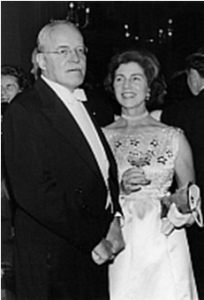
Poppy’s Moment
Although the mysteries behind the Kennedy assassination were not resolved by the Warren Commission, the rest of the world began to move on. Certainly, Poppy did. Though he lost the 1964 Senate election – as did his friend Jack Crichton the governor’s race – Poppy had helped set in motion events that would get him to Washington in two short years.
Bush wanted to carve out a new congressional district from that of Representative Albert Thomas, a new Deal Democrat who had played a key role in bringing NASA’s Space Center to Houston. By the time of Kennedy’s assassination, Thomas was showing signs of early senility. A key reason for President Kennedy’s visit to Texas that fateful week was to attend an event honoring Thomas, and generally to boost Democratic prospects for 1964.
In a watershed moment, Poppy and the GOP won a lawsuit they had filed in the fall of 1963 to force the state of Texas to redraw its gerrymandered congressional districts. This victory would play an important role in the state’s gradual shift from the Democratic to the Republican column, which would affect the balance of power in American politics for decades to come. Moreover, it would pave the way for Poppy’s election to the House of Representatives, and later his son’s political rise.
One specific result of Poppy Bush’s suit was the drawing of a “super-Republican” district tailor-made for him. Many of the people who lived there were East Coast trans-plants like Poppy himself, Ivy League graduates for whom tennis and martinis were a more natural choice than horseshoes and tequila. Poppy had done especially well in that area in his Senate race. So in 1966, Poppy sold his shares in Zapata Offshore, left the company in the hands of trusted associates, ran hard, won, and headed for Washington.
The Phoenix Program: “Pacification” of 20,000 People
Congress was a great place for a spy – even better, in some ways, than the CIA. Congressmen were expected to travel the world, looking into matters of interest to the United States. In December 1967, less than a year after Bush was sworn in, he was off to Indochina, with his CIA partner Thomas Devine in tow.
It was Christmas break, a time when congressmen often make overseas trips, but Bush and Devine did not have a typical agenda. Correspondence indicates that having arrived in Vietnam, Bush and Devine hastily canceled an appointment with the U.S. ambassador in favor of other, unstated activities.
For the CIA, the hot item at the time was the so-called Phoenix Program, a secret plan to imprison and “neutralize” suspected Vietcong. This was being rolled out at precisely the moment that Poppy and Devine arrived “in country.”
By the time CIA director William Colby admitted to the program in July 1971, more than twenty thousand people had been killed – many of them possibly innocent, officials later concluded. One person involved in Phoenix’s early stages was Felix Rodriguez, a Cuban exile and CIA operative. Rodriguez would go on to become a great friend of Poppy Bush’s, even visiting him in the White House.
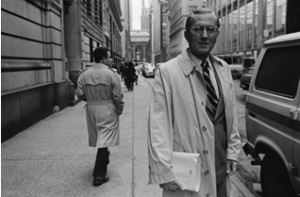
If J. Edgar Hoover’s 1963 memo was correct in mentioning “George Bush of the CIA” as an intermediary with Cuban exiles, the coincidence of Rodriguez’s activities in Vietnam with that of Bush’s visit raises questions as to how the two were connected.
In 1970 Rodriguez joined the CIA front company Air America, which allegedly played a role in trafficking heroin from Laos to the United States. The Laotian operation was led by Donald Gregg, who would later serve as national security adviser during Poppy Bush’s presidency.
When Bush and Devine traveled to Vietnam the day after Christmas 1967, Devine was in his new CIA capacity, operating under commercial cover. Handwritten notes from the trip show that Poppy was especially interested in the Phoenix program, which he referred to by the euphemism “pacification.”
The two remained in Vietnam until January 11, 1968. Whatever information they were seeking, they left just in time. Only three weeks after the freshman congressman from Texas and his CIA sidekick departed Saigon, the North Vietnamese and Vietcong launched the massive Tet Offensive.
A Disturbing Incident
Meanwhile, the Kennedy assassination had put into the White House Lyndon Baines Johnson, who had a long-standing but little-known relationship with the Bush family.
This dates back at least to 1953, when Prescott Bush joined Johnson in the U.S. Senate. Johnson was the powerful majority leader and Prescott had his own pipeline to the highest levels at the Eisenhower White House. That same year, Poppy Bush started Zapata Petroleum with Hugh and William Liedtke, who as law students at the University of Texas several years earlier had rented LBJ’s guesthouse. Later, Bush became close with LBJ’s chief financiers, George and Herman Brown, the founders of the construction giant Brown and Root (which later became part of Halliburton).
Pat Holloway, former attorney to both Poppy Bush and Jack Crichton, recounted to me an incident involving LBJ that had greatly disturbed him. This was around one p.m. on November 22, 1963, just as Kennedy was being pronounced dead. Holloway was heading home from the office and was passing through the reception area. The switchboard operator excitedly noted that she was patching the vice president through from Parkland Hospital to Holloway’s boss, firm senior partner Waddy Bullion, who was LBJ’s personal tax lawyer. The operator invited Holloway to listen in. LBJ was talking “not about a conspiracy or about the tragedy,” Holloway recalled.
I heard him say,”Oh, I gotta get rid of my goddamn Halliburton stock.” Lyndon Johnson was talking about the consequences of his political problems with his Halliburton stock at a time when the president had been officially declared dead. And that pissed me off . . . It really made me furious.
There are many other examples of LBJ’s apparent unconcern after the assassination, though none so immediate. For instance, on the evening of November 25, LBJ and Martin Luther King talked, and LBJ said, “It’s just an impossible period – we’ve got a budget coming up.”
That morning, he told Joe Alsop that “the president must not inject himself into, uh, local killings,” to which Alsop immediately replied, “I agree with that, but in this case it does happen to be the killing of the President.”
Also on the same day LBJ told Hoover, “We can’t be checking up on every shooting scrape in the country.”
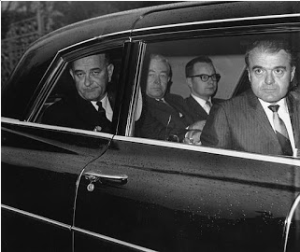
By 1964, with LBJ in the White House and Poppy Bush the Texas GOP nominee for U.S. Senate, their relationship was highly cordial. An intriguing, if oblique, note from LBJ’s assistant Leslie Carpenter to Walter Jenkins, a top LBJ adviser, dated August 14, 1964, referred to Poppy: “Someone may like to know that George Bush was in town today for the day . . . [Bush] also had a press conference. During it, he carefully refrained from saying anything critical of the President.”
LBJ has also been plausibly characterized as secretly rooting for Bush to beat the liberal Democratic candidate for Senate, Ralph Yarborough, whom LBJ disliked greatly; since the Democrats held a solid two-third majority in the Senate, LBJ knew that his party could afford to lose the seat.
In any case, while in Washington, Poppy had a warm relationship with Johnson, notwithstanding Bush’s persistent attacks on the Democratic Party, especially back in Texas.
One of the more peculiar relationships in an already bizarre enterprise resulted from Bush’s choice of a surrogate to run Zapata Offshore’s office in Medellín, Colombia. To begin with, there was the question of why a small, unprofitable company needed such far-flung outposts. Why, in particular, did it need one in Medellín, 150 miles from any offshore drilling locale – a city whose very name would later become synonymous with the cocaine trade? Bush’s choice to represent Zapata in Colombia was Judge Manuel B. Bravo, of Zapata County, Texas.
Judge Bravo’s singular claim to fame was his role in Lyndon Johnson’s fraud-ridden election to the U.S. senate in 1948. As reports of an extraordinarily close race came in on election night, Bravo continually revised upward the Johnson count from Zapata County’s Ballot Box 13 until LBJ was assured victory.
A federal investigation led to a trial, but by that time the ballots from Box 13 in Jim Wells County had conveniently disappeared from the judge’s office. The lack of evidence effectively ended Johnson’s peril. Johnson won by eighty-seven votes.
In 1967, President Johnson sent Poppy a note wishing him a happy birthday. The following year, LBJ’s decision not to seek reelection paved the way for Richard Nixon’s ascent to the presidency – and Nixon’s steady sponsorship of Poppy Bush’s own ascent to power. When Nixon was inaugurated in 1969, Bush took the unusual step of leaving the GOP festivities to see LBJ off at the airport. Soon thereafter, he was a guest at the LBJ ranch. There is no public record of what the two men talked about.
Certainly, it had been a tumultuous few years for America, and busy ones for Poppy. His astonishing ability to carry on parallel lives, one visible, one deeply hidden, continued undiminished. But soon, there would be an understudy: his namesake, George W. Bush.
For Part 1, please go here; Part 2, here; Part 3, here; Part 4, here; Part 5, here;Part 6, here; Part 7, here; Part 8, here; Part 9, here; Part 10, here.
[box]WhoWhatWhy plans to continue doing this kind of groundbreaking original reporting. You can count on it. But can we count on you? We cannot do our work without your support.
Please click here to donate; it’s tax deductible. And it packs a punch.[/box]
IMAGE: THUMBNAIL IMAGE: Jack Crichton IMAGE: Murchison IMAGE: Civil Defense IMAGE: CD Protect yourself IMAGE: Kennedys in coffee shop IMAGE: Jenner IMAGE: Dulles and Auchincloss IMAGE: Colby IMAGE: LBJ in car IMAGE: LBJ
